Pascal's triangle facts for kids
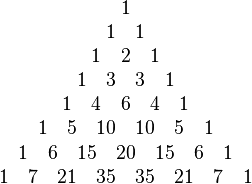
In mathematics, Pascal's triangle is a triangular array of the binomial coefficients arising in probability theory, combinatorics, and algebra. In much of the Western world, it is named after the French mathematician Blaise Pascal, although other mathematicians studied it centuries before him in Persia, India, China, Germany, and Italy.
The rows of Pascal's triangle are conventionally enumerated starting with row  at the top (the 0th row). The entries in each row are numbered from the left beginning with
at the top (the 0th row). The entries in each row are numbered from the left beginning with  and are usually staggered relative to the numbers in the adjacent rows. The triangle may be constructed in the following manner: In row 0 (the topmost row), there is a unique nonzero entry 1. Each entry of each subsequent row is constructed by adding the number above and to the left with the number above and to the right, treating blank entries as 0. For example, the initial number of row 1 (or any other row) is 1 (the sum of 0 and 1), whereas the numbers 1 and 3 in row 3 are added to produce the number 4 in row 4.
and are usually staggered relative to the numbers in the adjacent rows. The triangle may be constructed in the following manner: In row 0 (the topmost row), there is a unique nonzero entry 1. Each entry of each subsequent row is constructed by adding the number above and to the left with the number above and to the right, treating blank entries as 0. For example, the initial number of row 1 (or any other row) is 1 (the sum of 0 and 1), whereas the numbers 1 and 3 in row 3 are added to produce the number 4 in row 4.
Contents
Formula
The entry in the  th row and
th row and  th column of Pascal's triangle is denoted
th column of Pascal's triangle is denoted  . For example, the unique nonzero entry in the topmost row is
. For example, the unique nonzero entry in the topmost row is  . With this notation, the construction of the previous paragraph may be written as follows:
. With this notation, the construction of the previous paragraph may be written as follows:
 ,
,
for any non-negative integer  and any integer
and any integer  . This recurrence for the binomial coefficients is known as Pascal's rule.
. This recurrence for the binomial coefficients is known as Pascal's rule.
History
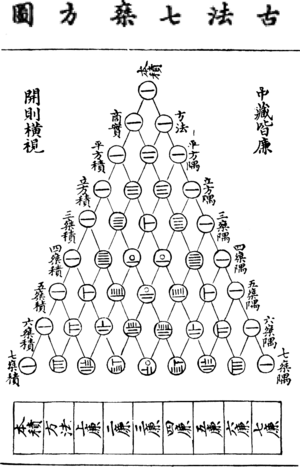
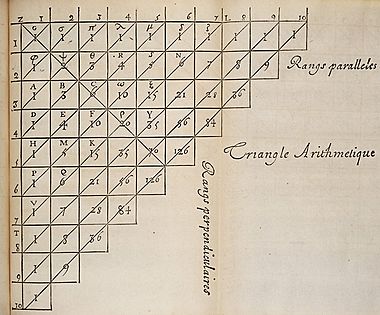
The pattern of numbers that forms Pascal's triangle was known well before Pascal's time. The Persian mathematician Al-Karaji (953–1029) wrote a now-lost book which contained the first formulation of the binomial coefficients and the first description of Pascal's triangle. It was later repeated by Omar Khayyám (1048–1131), another Persian mathematician; thus the triangle is also referred to as the Khayyam's triangle (مثلث خیام) in Iran. Several theorems related to the triangle were known, including the binomial theorem. Khayyam used a method of finding nth roots based on the binomial expansion, and therefore on the binomial coefficients.
Pascal's triangle was known in China during the early 11th century as a result of the work of the Chinese mathematician Jia Xian (1010–1070). During the 13th century, Yang Hui (1238–1298) presented the triangle and hence it is still known as Yang Hui's triangle (杨辉三角; 楊輝三角) in China.
In Europe, Pascal's triangle appeared for the first time in the Arithmetic of Jordanus de Nemore (13th century). The binomial coefficients were calculated by Gersonides during the early 14th century, using the multiplicative formula for them. Petrus Apianus (1495–1552) published the full triangle on the frontispiece of his book on business calculations in 1527. Michael Stifel published a portion of the triangle (from the second to the middle column in each row) in 1544, describing it as a table of figurate numbers. In Italy, Pascal's triangle is referred to as Tartaglia's triangle, named for the Italian algebraist Niccolò Fontana Tartaglia (1500–1577), who published six rows of the triangle in 1556. Gerolamo Cardano, also, published the triangle as well as the additive and multiplicative rules for constructing it in 1570.
Pascal's Traité du triangle arithmétique (Treatise on Arithmetical Triangle) was published posthumously in 1665. In this, Pascal collected several results then known about the triangle, and employed them to solve problems in probability theory. The triangle was later named for Pascal by Pierre Raymond de Montmort (1708) who called it "Table de M. Pascal pour les combinaisons" (French: Table of Mr. Pascal for combinations) and Abraham de Moivre (1730) who called it "Triangulum Arithmeticum PASCALIANUM" (Latin: Pascal's Arithmetic Triangle), which became the basis of the modern Western name.
Binomial expansions
Pascal's triangle determines the coefficients which arise in binomial expansions. For example, consider the expansion
 .
.
The coefficients are the numbers in the second row of Pascal's triangle:  ,
,  ,
,  .
.
In general, when a binomial like  is raised to a positive integer power of
is raised to a positive integer power of  , we have:
, we have:
 ,
,
where the coefficients  in this expansion are precisely the numbers on row
in this expansion are precisely the numbers on row  of Pascal's triangle. In other words,
of Pascal's triangle. In other words,
 .
.
This is the binomial theorem.
The entire right diagonal of Pascal's triangle corresponds to the coefficient of  in these binomial expansions, while the next diagonal corresponds to the coefficient of
in these binomial expansions, while the next diagonal corresponds to the coefficient of  and so on.
and so on.
To see how the binomial theorem relates to the simple construction of Pascal's triangle, consider the problem of calculating the coefficients of the expansion of  in terms of the corresponding coefficients of
in terms of the corresponding coefficients of  (setting
(setting  for simplicity). Suppose then that
for simplicity). Suppose then that
 .
.
Now
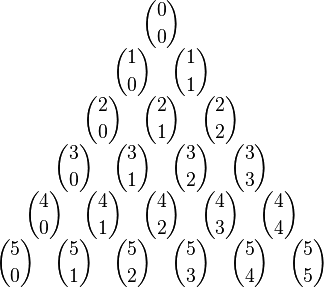
The two summations can be reorganized as follows:
(because of how raising a polynomial to a power works,  ).
).
We now have an expression for the polynomial  in terms of the coefficients of
in terms of the coefficients of  (these are the
(these are the  s), which is what we need if we want to express a line in terms of the line above it. Recall that all the terms in a diagonal going from the upper-left to the lower-right correspond to the same power of
s), which is what we need if we want to express a line in terms of the line above it. Recall that all the terms in a diagonal going from the upper-left to the lower-right correspond to the same power of  , and that the
, and that the  -terms are the coefficients of the polynomial
-terms are the coefficients of the polynomial  , and we are determining the coefficients of
, and we are determining the coefficients of  . Now, for any given
. Now, for any given  , the coefficient of the
, the coefficient of the  term in the polynomial
term in the polynomial  is equal to
is equal to  . This is indeed the simple rule for constructing Pascal's triangle row-by-row.
. This is indeed the simple rule for constructing Pascal's triangle row-by-row.
It is not difficult to turn this argument into a proof (by mathematical induction) of the binomial theorem.
Since  , the coefficients are identical in the expansion of the general case.
, the coefficients are identical in the expansion of the general case.
An interesting consequence of the binomial theorem is obtained by setting both variables  and
and  equal to one. In this case, we know that
equal to one. In this case, we know that  , and so
, and so
In other words, the sum of the entries in the  th row of Pascal's triangle is the
th row of Pascal's triangle is the  th power of 2. This is equivalent to the statement that the number of subsets (the cardinality of the power set) of an
th power of 2. This is equivalent to the statement that the number of subsets (the cardinality of the power set) of an  -element set is
-element set is  , as can be seen by observing that the number of subsets is the sum of the number of combinations of each of the possible lengths, which range from zero through to
, as can be seen by observing that the number of subsets is the sum of the number of combinations of each of the possible lengths, which range from zero through to  .
.
Combinations
A second useful application of Pascal's triangle is in the calculation of combinations. For example, the number of combinations of  items taken
items taken  at a time (pronounced n choose k) can be found by the equation
at a time (pronounced n choose k) can be found by the equation
 .
.
But this is also the formula for a cell of Pascal's triangle. Rather than performing the calculation, one can simply look up the appropriate entry in the triangle. Provided we have the first row and the first entry in a row numbered 0, the answer will be located at entry  in row
in row  . For example, suppose 8 jobs need to be filled but there are 10 candidates; the selection committee wants to know how many ways there are of selecting 8 from the 10. The answer is entry 8 in row 10, which is 45; that is, 10 choose 8 is 45.
. For example, suppose 8 jobs need to be filled but there are 10 candidates; the selection committee wants to know how many ways there are of selecting 8 from the 10. The answer is entry 8 in row 10, which is 45; that is, 10 choose 8 is 45.
Relation to binomial distribution and convolutions
When divided by  , the
, the  th row of Pascal's triangle becomes the binomial distribution in the symmetric case where
th row of Pascal's triangle becomes the binomial distribution in the symmetric case where  . By the central limit theorem, this distribution approaches the normal distribution as
. By the central limit theorem, this distribution approaches the normal distribution as  increases. This can also be seen by applying Stirling's formula to the factorials involved in the formula for combinations.
increases. This can also be seen by applying Stirling's formula to the factorials involved in the formula for combinations.
This is related to the operation of discrete convolution in two ways. First, polynomial multiplication corresponds exactly to discrete convolution, so that repeatedly convolving the sequence  with itself corresponds to taking powers of
with itself corresponds to taking powers of  , and hence to generating the rows of the triangle. Second, repeatedly convolving the distribution function for a random variable with itself corresponds to calculating the distribution function for a sum of n independent copies of that variable; this is exactly the situation to which the central limit theorem applies, and hence results in the normal distribution in the limit.
, and hence to generating the rows of the triangle. Second, repeatedly convolving the distribution function for a random variable with itself corresponds to calculating the distribution function for a sum of n independent copies of that variable; this is exactly the situation to which the central limit theorem applies, and hence results in the normal distribution in the limit.
Patterns and properties
Pascal's triangle has many properties and contains many patterns of numbers.
Rows
- The sum of the elements of a single row is twice the sum of the row preceding it. For example, row 0 (the topmost row) has a value of 1, row 1 has a value of 2, row 2 has a value of 4, and so forth. This is because every item in a row produces two items in the next row: one left and one right. The sum of the elements of row
 equals to
equals to  .
. - Taking the product of the elements in each row, the sequence of products (sequence A001142 in OEIS) is related to the base of the natural logarithm, e. Specifically, define the sequence
 for all
for all  as follows:
as follows:  Then, the ratio of successive row products is
Then, the ratio of successive row products is  and the ratio of these ratios is
and the ratio of these ratios is  The right-hand side of the above equation takes the form of the limit definition of
The right-hand side of the above equation takes the form of the limit definition of 
 .
.  can be found in Pascal's triangle by use of the Nilakantha infinite series.
can be found in Pascal's triangle by use of the Nilakantha infinite series. 
- The
 th row reads as the numeral
th row reads as the numeral  for all
for all  . See Extension to arbitrary bases.
. See Extension to arbitrary bases. - Some of the numbers in Pascal's triangle correlate to numbers in Lozanić's triangle.
- The sum of the squares of the elements of row n equals the middle element of row 2n. For example, 12 + 42 + 62 + 42 + 12 = 70. In general form:

- On any row n, where n is even, the middle term minus the term two spots to the left equals a Catalan number, specifically the (n/2 + 1)th Catalan number. For example: on row 4, 6 − 1 = 5, which is the 3rd Catalan number, and 4/2 + 1 = 3.
- In a row p where p is a prime number, all the terms in that row except the 1s are multiples of p. This can be proven easily, since if
 , then p has no factors save for 1 and itself. Every entry in the triangle is an integer, so therefore by definition
, then p has no factors save for 1 and itself. Every entry in the triangle is an integer, so therefore by definition  and
and  are factors of
are factors of  . However, there is no possible way p itself can show up in the denominator, so therefore p (or some multiple of it) must be left in the numerator, making the entire entry a multiple of p.
. However, there is no possible way p itself can show up in the denominator, so therefore p (or some multiple of it) must be left in the numerator, making the entire entry a multiple of p. - Parity: To count odd terms in row n, convert n to binary. Let x be the number of 1s in the binary representation. Then the number of odd terms will be 2x. These numbers are the values in Gould's sequence.
- Every entry in row 2n − 1, n ≥ 0, is odd.
- Polarity: When the elements of a row of Pascal's triangle are alternately added and subtracted together, the result is 0. For example, row 6 is 1, 6, 15, 20, 15, 6, 1, so the formula is 1 − 6 + 15 − 20 + 15 − 6 + 1 = 0.
Diagonals

The diagonals of Pascal's triangle contain the figurate numbers of simplices:
- The diagonals going along the left and right edges contain only 1's.
- The diagonals next to the edge diagonals contain the natural numbers in order. The 1-dimensional simplex numbers increment by 1 as the line segments extend to the next whole number along the number line.
- Moving inwards, the next pair of diagonals contain the triangular numbers in order.
- The next pair of diagonals contain the tetrahedral numbers in order, and the next pair give pentatope numbers.
The symmetry of the triangle implies that the nth d-dimensional number is equal to the dth n-dimensional number.
An alternative formula that does not involve recursion is  where n(d) is the rising factorial.
where n(d) is the rising factorial.
The geometric meaning of a function Pd is: Pd(1) = 1 for all d. Construct a d-dimensional triangle (a 3-dimensional triangle is a tetrahedron) by placing additional dots below an initial dot, corresponding to Pd(1) = 1. Place these dots in a manner analogous to the placement of numbers in Pascal's triangle. To find Pd(x), have a total of x dots composing the target shape. Pd(x) then equals the total number of dots in the shape. A 0-dimensional triangle is a point and a 1-dimensional triangle is simply a line, and therefore P0(x) = 1 and P1(x) = x, which is the sequence of natural numbers. The number of dots in each layer corresponds to Pd − 1(x).
Calculating a row or diagonal by itself
There are simple algorithms to compute all the elements in a row or diagonal without computing other elements or factorials.
To compute row  with the elements
with the elements  , begin with
, begin with  . For each subsequent element, the value is determined by multiplying the previous value by a fraction with slowly changing numerator and denominator:
. For each subsequent element, the value is determined by multiplying the previous value by a fraction with slowly changing numerator and denominator:
For example, to calculate row 5, the fractions are  ,
,  ,
,  ,
,  and
and  , and hence the elements are
, and hence the elements are  ,
,  ,
,  , etc. (The remaining elements are most easily obtained by symmetry.)
, etc. (The remaining elements are most easily obtained by symmetry.)
To compute the diagonal containing the elements  we again begin with
we again begin with  and obtain subsequent elements by multiplication by certain fractions:
and obtain subsequent elements by multiplication by certain fractions:
For example, to calculate the diagonal beginning at  , the fractions are
, the fractions are  , and the elements are
, and the elements are  , etc. By symmetry, these elements are equal to
, etc. By symmetry, these elements are equal to  , etc.
, etc.
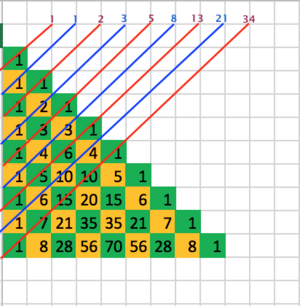
Overall patterns and properties
- The pattern obtained by coloring only the odd numbers in Pascal's triangle closely resembles the fractal known as the Sierpinski triangle. This resemblance becomes increasingly accurate as more rows are considered; in the limit, as the number of rows approaches infinity, the resulting pattern is the Sierpinski triangle, assuming a fixed perimeter. More generally, numbers could be colored differently according to whether or not they are multiples of 3, 4, etc.; this results in other similar patterns.
- In a triangular portion of a grid (as in the images below), the number of shortest grid paths from a given node to the top node of the triangle is the corresponding entry in Pascal's triangle. On a Plinko game board shaped like a triangle, this distribution should give the probabilities of winning the various prizes.
Image:Pascal's Triangle 4 paths.svg
- If the rows of Pascal's triangle are left-justified, the diagonal bands (colour-coded below) sum to the Fibonacci numbers.
-
-
1 1 1 1 2 1 1 3 3 1 1 4 6 4 1 1 5 10 10 5 1 1 6 15 20 15 6 1 1 7 21 35 35 21 7 1
-
Construction as matrix exponential
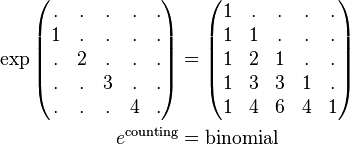
Due to its simple construction by factorials, a very basic representation of Pascal's triangle in terms of the matrix exponential can be given: Pascal's triangle is the exponential of the matrix which has the sequence 1, 2, 3, 4, ... on its subdiagonal and zero everywhere else.
Relation to geometry of polytopes
Pascal's triangle can be used as a lookup table for the number of elements (such as edges and corners) within a polytope (such as a triangle, a tetrahedron, a square, or a cube).
Number of elements of simplices
Let's begin by considering the 3rd line of Pascal's triangle, with values 1, 3, 3, 1. A 2-dimensional triangle has one 2-dimensional element (itself), three 1-dimensional elements (lines, or edges), and three 0-dimensional elements (vertices, or corners). The meaning of the final number (1) is more difficult to explain (but see below). Continuing with our example, a tetrahedron has one 3-dimensional element (itself), four 2-dimensional elements (faces), six 1-dimensional elements (edges), and four 0-dimensional elements (vertices). Adding the final 1 again, these values correspond to the 4th row of the triangle (1, 4, 6, 4, 1). Line 1 corresponds to a point, and Line 2 corresponds to a line segment (dyad). This pattern continues to arbitrarily high-dimensioned hyper-tetrahedrons (known as simplices).
To understand why this pattern exists, one must first understand that the process of building an n-simplex from an (n − 1)-simplex consists of simply adding a new vertex to the latter, positioned such that this new vertex lies outside of the space of the original simplex, and connecting it to all original vertices. As an example, consider the case of building a tetrahedron from a triangle, the latter of whose elements are enumerated by row 3 of Pascal's triangle: 1 face, 3 edges, and 3 vertices. To build a tetrahedron from a triangle, we position a new vertex above the plane of the triangle and connect this vertex to all three vertices of the original triangle.
The number of a given dimensional element in the tetrahedron is now the sum of two numbers: first the number of that element found in the original triangle, plus the number of new elements, each of which is built upon elements of one fewer dimension from the original triangle. Thus, in the tetrahedron, the number of cells (polyhedral elements) is 0 + 1 = 1; the number of faces is 1 + 3 = 4; the number of edges is 3 + 3 = 6; the number of new vertices is 3 + 1 = 4. This process of summing the number of elements of a given dimension to those of one fewer dimension to arrive at the number of the former found in the next higher simplex is equivalent to the process of summing two adjacent numbers in a row of Pascal's triangle to yield the number below. Thus, the meaning of the final number (1) in a row of Pascal's triangle becomes understood as representing the new vertex that is to be added to the simplex represented by that row to yield the next higher simplex represented by the next row. This new vertex is joined to every element in the original simplex to yield a new element of one higher dimension in the new simplex, and this is the origin of the pattern found to be identical to that seen in Pascal's triangle.
Number of elements of hypercubes
A similar pattern is observed relating to squares, as opposed to triangles. To find the pattern, one must construct an analog to Pascal's triangle, whose entries are the coefficients of (x + 2)row number, instead of (x + 1)row number. There are a couple ways to do this. The simpler is to begin with row 0 = 1 and row 1 = 1, 2. Proceed to construct the analog triangles according to the following rule:
That is, choose a pair of numbers according to the rules of Pascal's triangle, but double the one on the left before adding. This results in:
The other way of producing this triangle is to start with Pascal's triangle and multiply each entry by 2k, where k is the position in the row of the given number. For example, the 2nd value in row 4 of Pascal's triangle is 6 (the slope of 1s corresponds to the zeroth entry in each row). To get the value that resides in the corresponding position in the analog triangle, multiply 6 by 2position number = 6 × 22 = 6 × 4 = 24. Now that the analog triangle has been constructed, the number of elements of any dimension that compose an arbitrarily dimensioned cube (called a hypercube) can be read from the table in a way analogous to Pascal's triangle. For example, the number of 2-dimensional elements in a 2-dimensional cube (a square) is one, the number of 1-dimensional elements (sides, or lines) is 4, and the number of 0-dimensional elements (points, or vertices) is 4. This matches the 2nd row of the table (1, 4, 4). A cube has 1 cube, 6 faces, 12 edges, and 8 vertices, which corresponds to the next line of the analog triangle (1, 6, 12, 8). This pattern continues indefinitely.
To understand why this pattern exists, first recognize that the construction of an n-cube from an (n − 1)-cube is done by simply duplicating the original figure and displacing it some distance (for a regular n-cube, the edge length) orthogonal to the space of the original figure, then connecting each vertex of the new figure to its corresponding vertex of the original. This initial duplication process is the reason why, to enumerate the dimensional elements of an n-cube, one must double the first of a pair of numbers in a row of this analog of Pascal's triangle before summing to yield the number below. The initial doubling thus yields the number of "original" elements to be found in the next higher n-cube and, as before, new elements are built upon those of one fewer dimension (edges upon vertices, faces upon edges, etc.). Again, the last number of a row represents the number of new vertices to be added to generate the next higher n-cube.
In this triangle, the sum of the elements of row m is equal to 3m. Again, to use the elements of row 4 as an example: 1 + 8 + 24 + 32 + 16 = 81, which is equal to  .
.
Counting vertices in a cube by distance
Each row of Pascal's triangle gives the number of vertices at each distance from a fixed vertex in an n-dimensional cube. For example, in three dimensions, the third row (1 3 3 1) corresponds to the usual three-dimensional cube: fixing a vertex V, there is one vertex at distance 0 from V (that is, V itself), three vertices at distance 1, three vertices at distance √2 and one vertex at distance √3 (the vertex opposite V). The second row corresponds to a square, while larger-numbered rows correspond to hypercubes in each dimension.
Fourier transform of sin(x)n+1/x
As stated previously, the coefficients of (x + 1)n are the nth row of the triangle. Now the coefficients of (x − 1)n are the same, except that the sign alternates from +1 to −1 and back again. After suitable normalization, the same pattern of numbers occurs in the Fourier transform of sin(x)n+1/x. More precisely: if n is even, take the real part of the transform, and if n is odd, take the imaginary part. Then the result is a step function, whose values (suitably normalized) are given by the nth row of the triangle with alternating signs. For example, the values of the step function that results from:
compose the 4th row of the triangle, with alternating signs. This is a generalization of the following basic result (often used in electrical engineering):
is the boxcar function. The corresponding row of the triangle is row 0, which consists of just the number 1.
If n is congruent to 2 or to 3 mod 4, then the signs start with −1. In fact, the sequence of the (normalized) first terms corresponds to the powers of i, which cycle around the intersection of the axes with the unit circle in the complex plane: 
Extensions
Pascal's triangle may be extended upwards, above the 1 at the apex, preserving the additive property, but there is more than one way to do so.
To higher dimensions
Pascal's triangle has higher dimensional generalizations. The three-dimensional version is known as Pascal's pyramid or Pascal's tetrahedron, while the general versions are known as Pascal's simplices.
To complex numbers
When the factorial function is defined as  , Pascal's triangle can be extended beyond the integers to
, Pascal's triangle can be extended beyond the integers to  , since
, since  is meromorphic to the entire complex plane.
is meromorphic to the entire complex plane.
To arbitrary bases
Isaac Newton once observed that the first five rows of Pascal’s Triangle, considered as strings, are the corresponding powers of eleven. He claimed without proof that subsequent rows also generate powers of eleven. In 1964, Dr. Robert L. Morton presented the more generalized argument that each row  can be read as a radix
can be read as a radix  numeral, where
numeral, where  is the hypothetical terminal row, or limit, of the triangle, and the rows are its partial products. He proved the entries of row
is the hypothetical terminal row, or limit, of the triangle, and the rows are its partial products. He proved the entries of row  , when interpreted directly as a place-value numeral, correspond to the binomial expansion of
, when interpreted directly as a place-value numeral, correspond to the binomial expansion of  . More rigorous proofs have since been developed. To better understand the principle behind this interpretation, here are some things to recall about binomials:
. More rigorous proofs have since been developed. To better understand the principle behind this interpretation, here are some things to recall about binomials:
- A radix
 numeral in positional notation (e.g.
numeral in positional notation (e.g.  ) is a univariate polynomial in the variable
) is a univariate polynomial in the variable  , where the degree of the variable of the
, where the degree of the variable of the  th term (starting with
th term (starting with  ) is
) is  . For example,
. For example,  .
. - A row corresponds to the binomial expansion of
 . We can eliminate
. We can eliminate  from the expansion by setting
from the expansion by setting  . The expansion now typifies the expanded form of a radix
. The expansion now typifies the expanded form of a radix  numeral, as demonstrated above. Thus, when the entries of the row are concatenated and read in radix
numeral, as demonstrated above. Thus, when the entries of the row are concatenated and read in radix  they form the numerical equivalent of
they form the numerical equivalent of  . If
. If  for
for  , then the theorem holds for
, then the theorem holds for  with odd values of
with odd values of  yielding negative row products.
yielding negative row products.
By setting the row's radix (the variable  ) equal to one and ten, row
) equal to one and ten, row  becomes the product
becomes the product  and
and  , respectively. To illustrate, consider
, respectively. To illustrate, consider  , which yields the row product
, which yields the row product  . The numeric representation of
. The numeric representation of  is formed by concatenating the entries of row
is formed by concatenating the entries of row  . In the image above, the twelfth row denotes the product:
. In the image above, the twelfth row denotes the product:
with compound digits (delimited by ":") in radix  . The digits from
. The digits from  through
through  are compound because these row entries compute to values greater than or equal to
are compound because these row entries compute to values greater than or equal to  . To normalize the numeral, simply carry the first compound entry's prefix, that is, remove the prefix of the coefficient
. To normalize the numeral, simply carry the first compound entry's prefix, that is, remove the prefix of the coefficient  from its leftmost digit up to, but excluding, its rightmost digit, and use radix-
from its leftmost digit up to, but excluding, its rightmost digit, and use radix- arithmetic to sum the removed prefix with the entry on its immediate left, then repeat this process, proceeding leftward, until the leftmost entry is reached. In this particular example, the normalized string ends with
arithmetic to sum the removed prefix with the entry on its immediate left, then repeat this process, proceeding leftward, until the leftmost entry is reached. In this particular example, the normalized string ends with  for all
for all  . The leftmost digit is
. The leftmost digit is  for
for  , which is obtained by carrying the
, which is obtained by carrying the  of
of  at entry
at entry  . It follows that the length of the normalized value of
. It follows that the length of the normalized value of  is equal to the row length,
is equal to the row length,  . The integral part of
. The integral part of  contains exactly one digit because
contains exactly one digit because  (the number of places to the left the decimal has moved) is one less than the row length. Below is the normalized value of
(the number of places to the left the decimal has moved) is one less than the row length. Below is the normalized value of  . Compound digits remain in the value because they are radix
. Compound digits remain in the value because they are radix  residues represented in radix ten:
residues represented in radix ten:
See also
 In Spanish: Triángulo de Pascal para niños
In Spanish: Triángulo de Pascal para niños
- Bean machine, Francis Galton's "quincunx"
- Bell triangle
- Bernoulli's triangle
- Binomial expansion
- Euler triangle
- Floyd's triangle
- Gaussian binomial coefficient
- Hockey-stick identity
- Leibniz harmonic triangle
- Multiplicities of entries in Pascal's triangle (Singmaster's conjecture)
- Pascal matrix
- Pascal's pyramid
- Pascal's simplex
- Proton NMR, one application of Pascal's triangle
- Star of David theorem
- Trinomial expansion
- Trinomial triangle
- Polynomials calculating sums of powers of arithmetic progressions





![\begin{align}
\sum_{k=0}^{n} a_{k} x^{k+1} + \sum_{k=0}^n a_k x^k &=
\sum_{k=1}^{n+1} a_{k-1} x^{k} + \sum_{k=0}^n a_k x^k \\ [4pt] &=
\sum_{k=1}^{n} a_{k-1} x^{k} + \sum_{k=1}^n a_k x^k + a_0x^0 + a_{n}x^{n+1} \\[4pt] &=
\sum_{k=1}^{n} (a_{k-1} + a_k)x^{k} + a_0x^0 + a_{n}x^{n+1} \\[4pt] &=
\sum_{k=1}^{n} (a_{k-1} + a_k)x^{k} + x^0 + x^{n+1}
\end{align}](/images/math/1/9/8/198ca8699ab8ab290fcc3f5262639256.png)


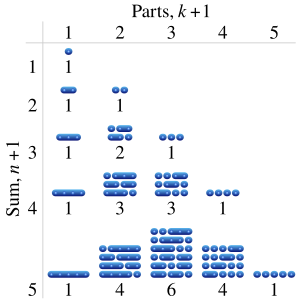



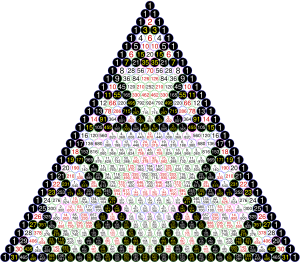


![\mathfrak{Re}\left(\text{Fourier} \left[ \frac{\sin(x)^5}{x} \right]\right)](/images/math/0/f/8/0f8c7be4c20a41641c90b86ac69213fd.png)
![\mathfrak{Re}\left(\text{Fourier} \left[ \frac{\sin(x)^1}{x}\right] \right)](/images/math/f/4/d/f4da8242556f4f23c978b7b837958770.png)

